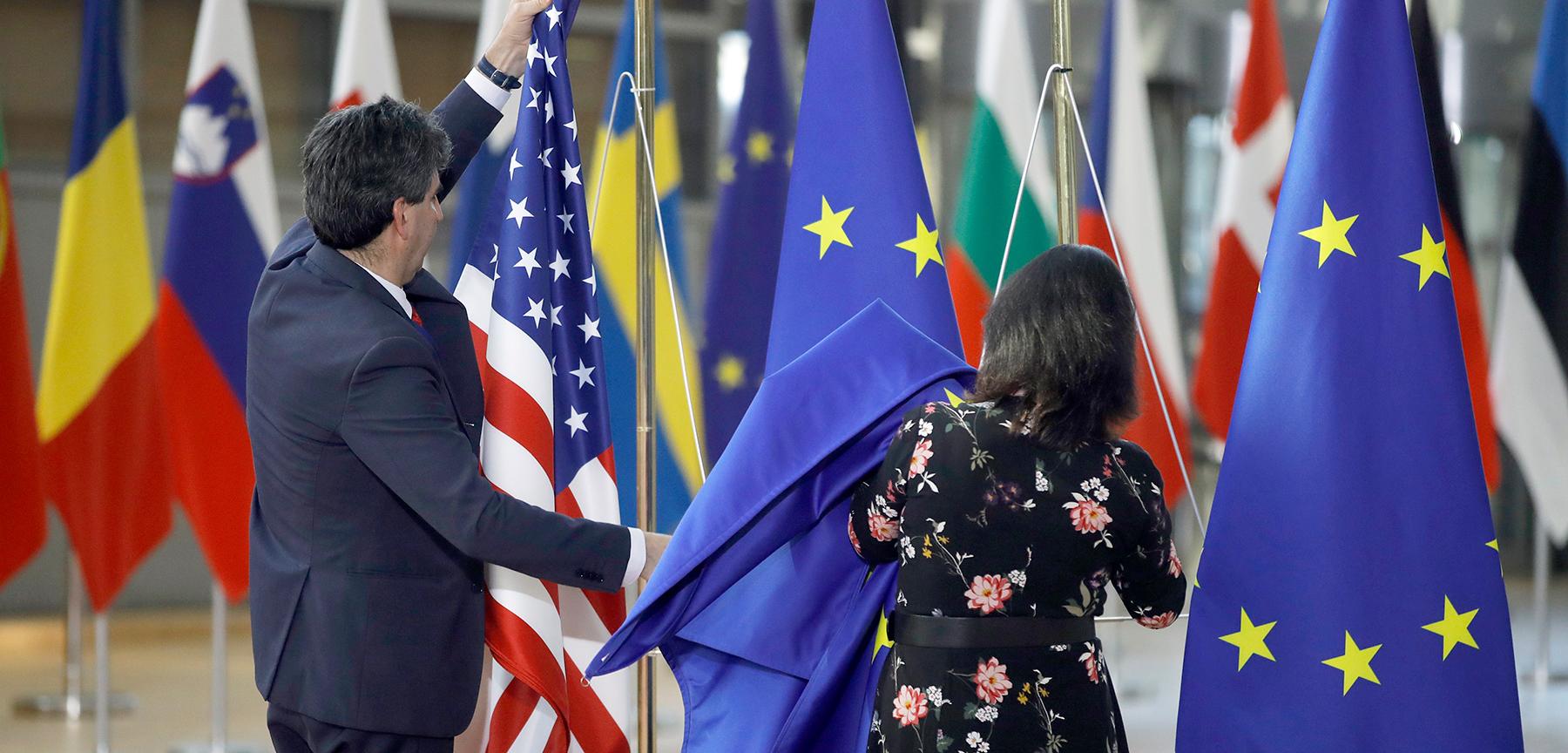The European Union has introduced its eleventh package of sanctions against Russia. The main intrigue of the package was restrictive measures against foreign countries and organisations that interact with Russia. It pertains to cooperation in those areas that are one way or another under EU sanctions. In other words, the question is: how exactly will the European Union achieve the promotion of its export control rules and other sanctions against Russia abroad?
Obviously, when developing new mechanisms, the EU was guided by the rich experience of the United States. Americans have been using three tools for a long time - secondary sanctions, the expansion of export restrictions, and criminal and administrative prosecutions. In the first case, the US Treasury simply imposes blocking sanctions on individuals and entities that are suspected of circumventing sanctions. Such measures were widely used against Russian counterparties abroad under all large packages of US sanctions in 2023.
In the EU, these measures only exist as legal mechanisms and law enforcement practice. Even last year, in Article 3 of Regulation 269/2014, additional grounds were added for the imposition of blocking sanctions. Paragraph H refers to them as assistance in circumventing restrictive measures against Russia. The new eleventh package of sanctions recorded the first case of the application of this legal mechanism: The Non-Public Joint Stock Company Scientific and Production Centre—Specialised Devices and Systems. So far, this is only the first case, but it is possible that the EU will focus on American volumes in the future. Moreover, this can apply both to bypassing export controls and financial sanctions. In addition, the EU authorities are already expanding the practice of criminal and administrative prosecution for circumventing sanctions.
Another new feature of the eleventh package was the EU trade sanctions against certain legal entities in third countries cooperating with the Russian defence industry. Among them are companies from Armenia, the United Arab Emirates, Iran, Syria, Uzbekistan and China. The appearance of companies from third countries in Annex IV does little to change the sanctions regime. However, those under EU jurisdiction have received a clear signal that, in relation to named persons, the supply of defence and dual-use goods may have legal consequences.
Another new feature of the eleventh package was the EU trade sanctions against certain legal entities in third countries cooperating with the Russian defence industry. Among them are companies from Armenia, the United Arab Emirates, Iran, Syria, Uzbekistan and China. The appearance of companies from third countries in Annex IV does little to change the sanctions regime. However, those under EU jurisdiction have received a clear signal that, in relation to named persons, the supply of defence and dual-use goods may have legal consequences.
Another measure that appeared in the eleventh package is sanctions against countries that are involved in the circumvention of sanctions. The mechanism is still only at the initial stage of its development. The EU authorities are showing great caution, fearing to spoil political relations with countries which remain friendly to Russia. As a limiting measure, export restrictions are possible on the supply to these countries of those goods that are prohibited for export in Russia, but which enter it through these third countries. Before using such a limiting measure, the EU authorities must negotiate and consult with the government of a country in order to cut off supplies to Russia. It is unlikely that Brussels will actively use the new instrument, but its very existence gives the European Commission additional legal grounds for purposeful work with the governments of countries friendly to Moscow.
The European Union has introduced its eleventh package of sanctions against Russia. The main intrigue of the package was restrictive measures against foreign countries and organisations that interact with Russia. It pertains to cooperation in those areas that are one way or another under EU sanctions. In other words, the question is: how exactly will the European Union achieve the promotion of its export control rules and other sanctions against Russia abroad?
EU controls on exports to Russia include a wide range of restrictions, which are fixed in EU Council Regulation 833/2014. They can be divided into several categories. First of all, they apply to military and dual-use goods. Almost all of them are banned for delivery to Russia. This includes a wide range of products, many of which have civilian uses—electronics, lasers, sensors, etc. The list of such goods is reflected in EU Council Regulation 2021/821 and supplemented by the list from Annex VII of Regulation 833/2014. The next group is “luxury goods”, which includes a wide range of household and other goods above a certain price threshold. Another important group is manufactured goods that can contribute to the development of Russia. This includes hundreds of itemised industrial goods—from electrical engineering products and ball bearings to paper and glass. Any person or entity under EU jurisdiction is prohibited from supplying these goods to Russia without the permission of the relevant departments in individual countries of the Union. But what about those outside EU jurisdiction, as well as individual countries that can turn a blind eye and even directly facilitate such supplies?
Obviously, when developing new mechanisms, the EU was guided by the rich experience of the United States. Americans have been using three tools for a long time - secondary sanctions, the expansion of export restrictions, and criminal and administrative prosecutions. In the first case, the US Treasury simply imposes blocking sanctions on individuals and entities that are suspected of circumventing sanctions. Such measures were widely used against Russian counterparties abroad under all large packages of US sanctions in 2023. Citizens and companies from India, China, the United Arab Emirates, Switzerland, Liechtenstein, Cyprus, Malta, etc. fell under secondary sanctions. In each such case, the Americans had no problems with the official authorities of these countries. By default, it is understood that these persons acted at their own peril and risk, and not on the order of the government in their jurisdiction. In the second case, the US Department of Commerce usually includes suspicious companies in the Entity List, prohibiting certain transactions with them. Finally, the Justice Department, the Treasury Department, the Department of Commerce and the US Department of State have long worked out mechanisms for identifying schemes to circumvent sanctions and prosecute their participants in a criminal or administrative manner.
In the EU, these measures only exist as legal mechanisms and law enforcement practice. Even last year, in Article 3 of Regulation 269/2014, additional grounds were added for the imposition of blocking sanctions. Paragraph H refers to them as assistance in circumventing restrictive measures against Russia. The new eleventh package of sanctions recorded the first case of the application of this legal mechanism: The Non-Public Joint Stock Company Scientific and Production Centre—Specialised Devices and Systems. The motivation part states that the company was involved in circumventing EU restrictions through a partnership with the Dutch company Woerd-Tech BV. So far, this is only the first case, but it is possible that the EU will focus on American volumes in the future. Moreover, this can apply both to bypassing export controls and financial sanctions. In addition, the EU authorities are already expanding the practice of criminal and administrative prosecution for circumventing sanctions.
Another new feature of the eleventh package was the EU trade sanctions against certain legal entities in third countries cooperating with the Russian defence industry. Among them are companies from Armenia, the United Arab Emirates, Iran, Syria, Uzbekistan and China. These companies are placed in Annex IV of Regulation 833/2014. Now the Regulations will clarify that the named companies have commercial ties or otherwise contribute to the Russian defence sector. At the same time, their inclusion in the list does not mean sanctions against the governments of the countries where the entities are registered. In addition, the list itself implies very specific restrictions. Named companies are exempt from military and dual-use restrictions. The inclusion of Russian companies in this list was understandable—those for which, for example, humanitarian exemptions could not be obtained. But the effect of this rule on companies in third countries raises questions about how exactly this measure will be applied. In any case, the appearance of companies from third countries in Annex IV does little to change the sanctions regime. However, those under EU jurisdiction have received a clear signal that, in relation to named persons, the supply of defence and dual-use goods may have legal consequences.
Another measure that appeared in the eleventh package is sanctions against countries that are involved in the circumvention of sanctions. The mechanism is still only at the initial stage of its development. The EU authorities are showing great caution, fearing to spoil political relations with countries which remain friendly to Russia. As a limiting measure, export restrictions are possible on the supply to these countries of those goods that are prohibited for export in Russia, but which enter it through these third countries. Before using such a limiting measure, the EU authorities must negotiate and consult with the government of a country in order to cut off supplies to Russia. It is unlikely that Brussels will actively use the new instrument, but its very existence gives the European Commission additional legal grounds for purposeful work with the governments of countries friendly to Moscow.
The rest of the eleventh package can be considered as movement along a well-trodden path. The list of citizens and organisations of Russia that fall under blocking financial sanctions has been expanded. Now it includes 244 legal entities and 1,572 individuals. The broadcasting of a number of Russian media outlets has been blocked. Bans on imports of ferrous metallurgy products are being extended, including deliveries through third countries. New categories have also appeared in the list of prohibited Russian imports. Export controls on dual-use goods have been expanded. The same applies to "luxury goods" - following the example of the United States, some categories of consumer electronics, in particular, were banned. Export restrictions on manufactured goods have been significantly expanded. Transport restrictions were added, including the access of Russian vehicles to the EU road network. Restrictions are being tightened on ships that violate price threshold requirements for the transportation of Russian oil and oil products, as well as circumventing EU sanctions in this area. In particular, they will be denied access to the ports of EU countries. Exceptions for oil supplies via the Druzhba pipeline have been removed. At the same time, the new restrictions were somehow predictable and there has been practically no change to the logic of their application. The course towards the economic blockade of Russia continues. Russia itself continues its policy of adapting to new restrictive measures.
First published in the Valdai Discussion Club.






